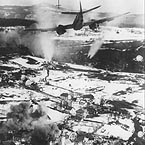DBS
Posts: 513
Joined: 4/29/2004
Status: offline

|
Further to J Boomer's comments above, have just consulted the Canadian Army Official History, pp291-2, which is essentially a good precis of the large PDF to which he linked.
The context for the reformation of 6th Canadian Division was a parliamentary statement by the PM on 4 April 45. He promised that the Division would concentrate in Canada before deploying to the Pacific, that no-one currently serving in Europe would be expected to serve in the Pacific without having gone home first, and that the force would be 100% volunteer.
There was no shortage of volunteers, but there was a shortage of suitable volunteers. 9,943 officers and 68,256 ORs in Europe volunteered for Pacific service, but only 2,796 + 36,386 were judged wholly suitable (age, fitness, etc). The problem was that the planning estimate was for 30,000 all ranks in the Canadian expeditionary force with a further 33,600 reinforcements/replacements in training.
The infantry battalions were to use the same identities as those in 1st Canadian Div, to mark their history as the first to deploy overseas in the war. Although using US organisation, each "Regiment" was to be commanded by a Brigadier, not a Colonel. The Recce "Troop" was the Royal Montreal Regiment.
The 13th Bde used on Kiska was definitely not part of the force, having been withdrawn in Jan 44 since Japanese interest in the Aleutians had vanished, although it had set a bit of a precedent by being at least notionally reorganised along US lines, albeit with the odd variation - a fourth infantry battalion in lieu of a combat engr bn. And of course one third of the personnel in the US 1st Special Service Force's six infantry battalions had been Canadian.
With regards to mariandavid's musing on the routing of CW troops to theatre, the July 45 directive to Mountbatten to my mind suggests that via India was not totally out of the question - Mountbatten might have whinged about Indian resources, but whether London would have been suitably sensitive is perhaps debateable. They were certainly warning him off to provide two divisions' worth of assault lift - whether London would have envisaged that being sent all the way across the Pacific for a US or Canadian rendezvous seems perhaps questionable.
Returning to J Boomer's linked PDF, what is interesting are the quotes on pp106-7 regarding the mooted CW Corps. The way I interpret that is that the British and US were agreed in principle on the desirability of a three divisional CW Corps, and assumed that the 6th Canadian would be part of this; but that the Canadian CGS was not inclined since he thought that the Division's integration with the US was too far advanced. To my mind this suggests that the CGS was not convinced that the supposed reorganisation and logistic support of the CW Corps along US lines would not be as comprehensive as that which the Canadians had already implemented.
|
 Printable Version
Printable Version













 Dutch
Dutch

 AAR can recall his frustration with the land combat model. I bet Sneer is really looking forward to a rematch with RaverDave.
AAR can recall his frustration with the land combat model. I bet Sneer is really looking forward to a rematch with RaverDave.
 New Messages
New Messages No New Messages
No New Messages Hot Topic w/ New Messages
Hot Topic w/ New Messages Hot Topic w/o New Messages
Hot Topic w/o New Messages Locked w/ New Messages
Locked w/ New Messages Locked w/o New Messages
Locked w/o New Messages Post New Thread
Post New Thread